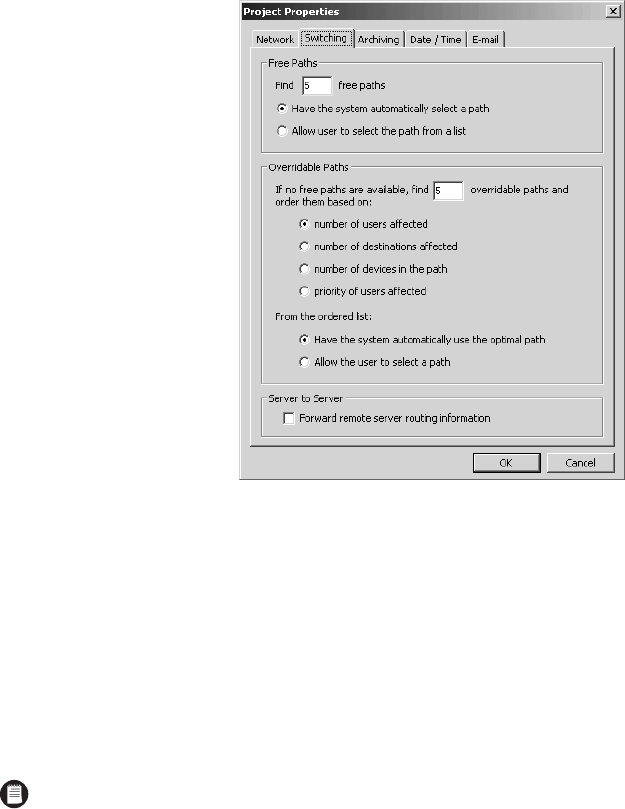
136 C1553M-B (4/05)
SWITCHING TAB
Figure 170. Switching Tab
The Switching tab allows you to specify how you want the server to select the switch path when a user or script accesses a video or audio
device.
The server uses free paths (paths that are not in use) whenever possible. If there is only one free path, the server uses it automatically. When
there are two or more free paths, the server finds as many free paths as you have specified, then either automatically uses the path through the
least number of devices or presents the list to the user to select from.
A user or script with higher priority can override use of a path by a user or script with lower priority. In this case, the path is considered to be
overridable. The server uses overridable paths only when there are no free paths. If there is only one overridable path available, the server uses
it automatically. When there are two or more overridable paths available, the server finds as many overridable paths as you have specified, sorts
them according to your specification, then either automatically uses the optimal path or presents the list to the user to select from.
1. Free paths: Type the number of free paths you want the server to find in the “Find free paths” box.
If you want the server to automatically use the path it found that involves the fewest number of devices, select “Have the system automat-
ically use the path through the least number of devices.” If you want the server to present the list of free paths to the user to select from,
select “Allow the user to select a path.”
Limiting the number of free paths speeds up switching. Limiting the number of free paths also keeps the list presented to the user a man-
ageable length, when the user is allowed to select the path.
2. Overridable paths: Type the number of overridable paths you want the server to find in the “Find overridable paths” box.
Select the criterion you want the server to use when finding overridable paths. You can choose to find paths that minimize the number of
users affected, paths that minimize the number of destinations affected, paths that minimize the number of devices in the path, or paths
that affect the lowest priority users.
If you want the server to automatically use the optimal path from the list, click “Have the system automatically use the optimal path.” If you
want the server to present the list to the user to select from, click “Allow the user to select a path.” When presented to the user, the list is
sorted with the minimal path at the top of the list.
3. Server to Server: In a situation in which three (or more) servers have three-way server ties, it is possible for two of the servers to
monopolize the other server’s ties. Clearing Forward remote server routing information prevents other servers from monopolizing your
server’s available paths. To allow other servers to route signals through your server, select Forward remote server routing information.
Refer to Prevent Other Servers from Monopolizing Your Ties in the Server Ties section for more information on the types of situation in
which other servers might be able to monopolize your ties.
NOTE: In most cases, automatic path selection is used.


















